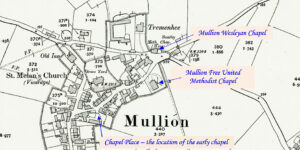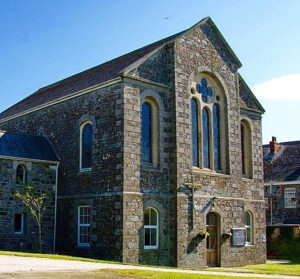Mapping Methodism – Mullion Wesleyan Methodist Association / UMFC
Categories Mapping Methodism0 Comments 
This profile of Mullion WMA/UMFC has been compiled by Jo Lewis.
This history of the Mullion United Methodist Church is written with reference to the history of the Mullion Wesleyan Church. http://cornishstory.com/2021/03/05/mapping-methodism-mullion-wesleyan-chapel/
John Wesley visited Mullion on 7 September 1762 and there was an existing society, the Mullion society.
Mullion Early Wesleyan Meeting place (Wesleyan Commerative Stone)Retuning into Mullion to go to the West of the village, there is a commemorative stone on the Poldhu road (west of Mullion village). It was engraved shortly after 1762 to celebrate the visit of John Wesley to Mullion. Adjacent to the stone is a large C20 granite slab bearing the inscription: PARC VENTON (SPRING FIELD) JOHN WESLEY PREACHED HERE ON 7TH SEPTEMBER 1762 METHODISTS MET AT ANGROUSE (THE CROSS) BETWEEN 1758 AND 1791 FOLLOWING THE PREACHING OF WM. HITCHENS AND UNDER THE LEADERSHIP OF URSULA TRIGGS DAUGHTER OF REV WILLS, VICAR OF MULLION, AND WIFE OF THOMAS TRIGGS, SOCIETY STEWARD ERECTED BY HER DESCENDANTS 1978. https://mullionguide.co.uk/mullion-history/
1785, Mullion was the only Methodist Society in Meneage.
The first chapel in Mullion was reportedly built in 1791 with the second in 1815 (Genuki – chapel opened in 1805) on the land of William Foxwell who was leader of the Mullion Methodist Society from this time until 1837. He is described as “a local preacher for fifty years in a branch of the Methodist Episcopal church and he built a chapel on his place; later he joined the Wesleyan Association and was a great temperance worker. He studied astronomy and was a great scholar.”
1807: William Foxwell was one of two “stout-hearted Methodist local preachers” who led others to make an attempt to reach the wrecked MHS Anson, so as to see if anyone remained on board and succeeded in rescuing survivors, for which he received a medal.
https://iagenweb.org/fayette/hist/1910/925.htm
Examination of William Foxwell’s will (Kresen Kernow document) shows that he owned a lot of property in and round Mullion village. It is presumed that the Chapel built in 1815 is that shown on early maps on Chapel Place, south of the road through Mullion.
Wesleyan Preaching plans show services in 1828 and 1833, so at this point the Mullion Methodists seem to be as one.
However, this Chapel became a Wesleyan Methodist Association Chapel (the WMA formed in the 1830s) and the Wesleyan Chapel was built in the 1840 at Tremenhee in Churchtown. It is assumed that the ‘Warrenite controversy” of 1834 to 1835 caused the split in the Mullion Methodists (possibly in 1837, when William Foxwell stopped as leader of the Mullion Methodist Society to lead the WMA). Theophilus George, the grandson of Theophilus George (a member of the Mullion Society in 1767) reportedly crossed the road from the WMA chapel (Chapel Place) to the new Wesleyan.
1857: The Wesleyan Methodist Association and the Wesleyan Reform Church amalgamated to become the United Methodist Free Churches
Assumed 1857: Became a United Methodist Free Church, presumably after 1857 when the WMA joined with the Wesleyan Reform to become the United Methodist Free Churches.
1864: Baptisms registered at this chapel.
1867: Registered in return as a United Methodist Free Churches although the Gazetteer of England & Wales of 1870 still records chapels for Wesleyans and Association Methodists in Mullion.
1970s: The old chapel was sold. A building still exists on the site (2 Chapel Place) with same configuration and may well be a conversion. Interestingly the small building immediately behind it (1 Chapel Place) is called The Vestry and can be seen on line. https://themovemarket.com/tools/propertyprices/the-vestry-churchtown-mullion-helston-tr12-7hj
1877/8 UMFC
 Mullion UMFC
Mullion UMFC
Located in Churchtown.
A second chapel was built in 1877 (opened 1878) in Mullion Churchtown almost directly opposite the Wesleyan. It was larger and more ornate than the Wesleyan. There was clearly a degree of rivalry in the village!
The 1878 Chapel was built over a school room and the architect was James Hicks of Redruth. (Western Morning News September 30 1878 / and the West Briton and Cornwall Advertiser October 3, 1878)
1879: New UMFC erected at Mullion. (West Briton and Cornwall Advertiser – Monday 30 September 1878)
There are documents in Kresen Kernow showing poems and notes on the building of the new chapel.
Heritage Gateway: United Methodist Free chapel over schoolroom. Local rubble with granite dressings. 2 storeys; 3-bay pedimented front with central bay broken forward and with large Gothic style 3-light window with quatrefoil tracery; Flanking single-light windows, all under round arches. Low forecourt walls with granite copings and monolith gate-piers. https://www.heritagegateway.org.uk/Gateway/Results_Single.aspx?uid=MCO32469&resourceID=1020
The chapel has fine stained glass windows which are recorded here:(https://www.cornishstainedglass.org.uk/mgsnona/church.xhtml?churchid=380)
By the 1900s it is reported that the congregation at the UM chapel was larger than that of the Wesleyan although the latter had a bigger Sunday school.
1903: Building alterations proposal. (Cornishman – Thursday 10 December 1903)
1906: Maps still show it as Methodist Chapel (Free United).
1907: The Methodist New Connexion, Bible Christians and United Methodist Free Churches amalgamated to become the United Methodist Church.
1907: Became a United Methodist Church although Kellys in 1902 already reported it as a United Methodist Chapel.
Circa 1912: A visting preacher (Miss A G Carkeek of Hayle) was so popular that the smaller Wesleyan Chapel could not accommodate the congregation. Service then moved to the bigger UM chapel and continued to be held there for subsequent years. This was probably the start of the decline of the Wesleyan Chapel in the village.
1932: The Wesleyan, Primitive Methodist and the United Methodist Church amalgamated to become the Methodist Church of Great Britain.
1932: Became Mullion Methodist Church. The Wesleyan seems to have become Mullion Methodist Chapel, although did not remain open for long. With dwindling population, the final Wesleyan service was conducted in December 1933, and the congregations amalgamated into the Mullion Methodist Church.
Mullion Methodist Church remains open, part of the Lizard and Mounts Bay Methodist Circuit. https://www.lizardandmountsbay.org/our-churches.
Further reading:
https://kresenkernow.org/SOAP/search/RelatedNameCode.keyword/CRO%7CUK%7C1152/
